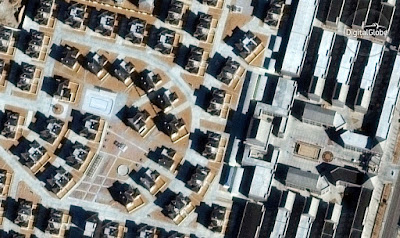China has built dozens of "Ghost Cities" - not necessarily entire cities but new housing areas that far exceed demand and are therefore mostly empty. The poorly regulated climate of the country has contributed to fast growth in construction projects and made it difficult to get a good accounting of where all of these projects are located. Baidu, China's most popular search engine, used an algorithm to locate these places by comparing location data from mobile devices to housing units. Places with a high density of housing, but low mobile use are assumed to be areas of vacant housing. The map below shows 20 of the top 50 cities for vacancy rates. They do not show all cities or rank them for fear of having a negative impact on real estate sales.
The Baidu study used Baidu Maps, their mapping platform to determine density by using points of interest. The study is imperfect for many reasons, for example mobile use as a proxy for activity excludes people that do not use these devices. The study also factors in tourist areas as places that are empty during certain times of the year.
The study found that most of these "ghost" cities are "second or third tier" cities-tiers are determined by income, education, technology and other factors. They are also mostly clustered in the east and especially the northeast. Inner Mongolia is also well represented. These findings agree with a map compiled the South China Morning Post.
This map shows a "demolition index" based on future supply versus future demand for housing. The redder end of the spectrum are cities that are most likely to become ghost cities. The results can be viewed interactively here. From the article:
Erenhot, Inner Mongolia - Large mansions along empty, sand blown streets.
Dongsheng, also in Inner Mongolia
More voyeuristic pictures can be seen at Business Insider
The Baidu study used Baidu Maps, their mapping platform to determine density by using points of interest. The study is imperfect for many reasons, for example mobile use as a proxy for activity excludes people that do not use these devices. The study also factors in tourist areas as places that are empty during certain times of the year.
The study found that most of these "ghost" cities are "second or third tier" cities-tiers are determined by income, education, technology and other factors. They are also mostly clustered in the east and especially the northeast. Inner Mongolia is also well represented. These findings agree with a map compiled the South China Morning Post.
"From the map, the 'ghost towns' are clustered in northeast China, where local economies rely heavily on natural resources, heavy industries and farming, and are not diversified enough to offer a variety of jobs."Though some of these places and beginning to get inhabited, Business Insider recently used Digital Globe to showcase how empty many of these places still are. Here are a couple of examples.
Erenhot, Inner Mongolia - Large mansions along empty, sand blown streets.
Dongsheng, also in Inner Mongolia
More voyeuristic pictures can be seen at Business Insider





No comments:
Post a Comment